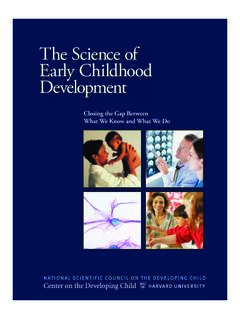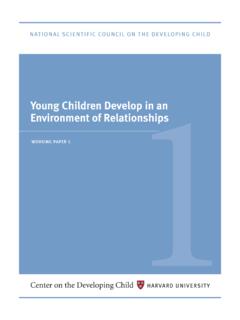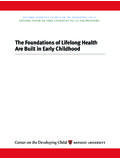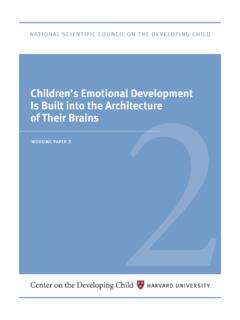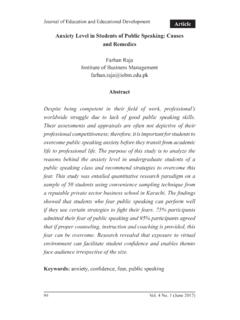Transcription of Persistent Fear and Anxiety Can Affect Young Children’s ...
1 9. Persistent Fear and Anxiety Can Affect Young children 's Learning and Development working paper 9. members contributing members Jack P. Shonkoff, , Chair susan nall bales Julius B. Richmond FAMRI Professor of Child Health and President, FrameWorks Institute Development, Harvard School of Public Health and Harvard Graduate School of Education; Professor of Pediatrics, philip a. fisher, Harvard Medical School and children 's Hospital Boston; Professor of Psychology, University of Oregon Director, Center on the Developing Child, Harvard University Senior Research Scientist, Oregon Social Learning Center & Center for Research to Practice Pat Levitt, , Science Director Director, Zilkha Neurogenetic Institute; Provost Professor of william greenough, Neuroscience, Psychiatry & Pharmacy.
2 Chair, Department of Swanlund Professor of Psychology, Psychiatry, and Cell and Cell and Neurobiology, Keck School of Medicine, University of Developmental Biology; Director, Center for Advanced Study Southern California at University of Illinois, Urbana-Champaign W. Thomas Boyce, eric knudsen, Sunny Hill Health Centre/BC Leadership Chair in Child Edward C. and Amy H. Sewall Professor of Neurobiology, Development; Professor, Graduate Studies and Medicine, Stanford University School of Medicine University of British Columbia, Vancouver Deborah phillips, Judy Cameron, Professor of Psychology and Associated Faculty, Public Policy Professor of Psychiatry, University of Pittsburgh Institute; Co-Director, Research Center on children in the , Georgetown University Greg J.
3 Duncan, Distinguished Professor, Department of Education, arthur J. rolnick, University of California, Irvine Senior Vice President and Director of Research, Federal Reserve Bank of Minneapolis Nathan A. Fox, Distinguished University Professor; Director, Child Development Laboratory, University of Maryland College Park partners Megan Gunnar, the frameworks institute Regents Professor and Distinguished McKnight University the national governors association center for best practices Professor, Institute of Child Development, University the national conference of state legislatures of Minnesota Linda C.
4 Mayes, Arnold Gesell Professor of Child Psychiatry, Pediatrics, and sponsors Psychology, Yale Child Study Center; the birth to five policy alliance Special Advisor to the Dean, Yale School of Medicine the buffett early childhood fund Palix foundation Bruce S. McEwen, Alfred E. Mirsky Professor; Head, Harold and Margaret Milliken Hatch Laboratory of Neuroendocrinology, The Rockefeller University Charles A. Nelson III, Richard David Scott Chair in Pediatric Developmental Medicine Research, children 's Hospital Boston; Professor of Pediatrics and Neuroscience, Harvard Medical School Ross Thompson, Professor of Psychology, University of California, Davis About the Authors The National Scientific Council on the Developing Child, housed at the Center on the Developing Child at Harvard University, is a multi- disciplinary collaboration designed to bring the science of early childhood and early brain development to bear on public decision- making.
5 Established in 2003, the Council is committed to an evidence-based approach to building broad-based public will that transcends political partisanship and recognizes the complementary responsibilities of family, community, workplace, and government to promote the well-being of all Young children . For more information, go to Please note: The content of this paper is the sole responsibility of the Council and does not necessarily represent the opinions of the funders or partners. Suggested citation: National Scientific Council on the Developing Child (2010). Persistent Fear and Anxiety Can Affect Young children 's Learning and Development: Working Paper No.
6 9. February 2010, National Scientific Council on the Developing Child, Center on the Developing Child at Harvard University The Issue ensuring that Young children have safe, secure environments in which to grow, learn, and develop healthy brains and bodies is not only good for the children themselves but also builds a strong foundation for a thriving, prosperous society. Science shows that early exposure to cir- cumstances that produce Persistent fear and chronic Anxiety can have lifelong consequences by disrupting the developing architecture of the brain. Unfortunately, many Young children are ex- posed to such circumstances.
7 While some of these experiences are one-time events and others may reoccur or persist over time, all of them have the potential to Affect how children learn, solve prob- lems, and relate to others. All children experience fears during childhood, in- lack information about the prevalence of these cluding fear of the dark, monsters, and strangers. situations in their communities. Critically, 1 in These fears are normal aspects of development and every 7 children , and nearly 1 out of every 40. are temporary in nature. In contrast, threatening infants, in the United States experience some circumstances that persistently elicit fear and anxi- form of maltreatment, including chronic ne- ety predict significant risk for adverse long-term glect or physical, emotional, or sexual ,2.
8 Outcomes from which children do not recover eas- Child maltreatment has been shown to occur ily. Physical, sexual, or emotional abuse; significant most often in families that face excessive levels maltreatment of one parent by the other; and the of stress, such as that associated with commu- Persistent threat of violence in the community are nity violence, parental drug abuse, or signifi- examples of such threatening circumstances in a cant social Research also tells us that child's environment. nearly half of children living in poverty witness Studies show that experiences like abuse and violence, or are indirectly victims of exposure to violence can cause fear and chronic Clearly, for children in these circumstances, the Anxiety in children and that these states trig- frequent and repetitive threats around them ger extreme, prolonged activation of the body's stress response system.
9 In studies with animals, Science shows that exposure to circumstances this type of chronic activation of the stress system has been shown to disrupt the efficiency that produce Persistent fear and chronic Anxiety of brain circuitry and lead to both immediate and long-term physical and psychological prob- can have lifelong consequences by disrupting the lems. This is especially true when stress-system overload occurs during sensitive periods of brain developing architecture of the brain. development. While much of the evidence for the effects of stress on the development of brain architecture comes from animal studies, strong create the potential for heightened fear and similarities in the processes of brain develop- chronic Anxiety .
10 Ment across species indicate that experiences Behavioral neuroscience research in ani- of Persistent fear and chronic Anxiety likely ex- mals tells us that serious, fear-triggering expe- ert similarly adverse impacts on the developing riences elicit physiological responses that Affect brain in humans. Thus, stress-system overload the architecture of the brain as it is developing. can significantly diminish a child's ability to These experiences cause changes in brain activ- learn and engage in typical social interactions ity and have been shown to have long-term, ad- across the lifespan.
